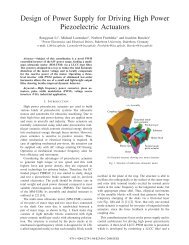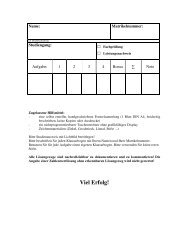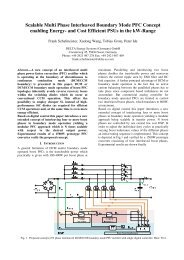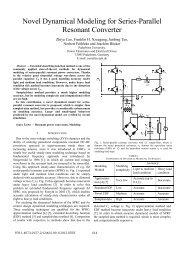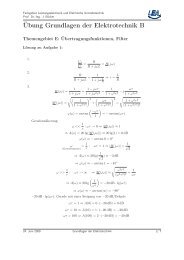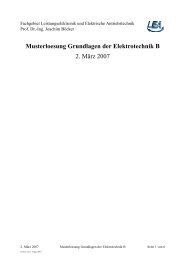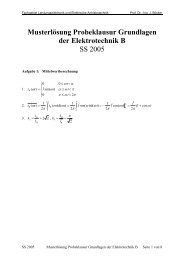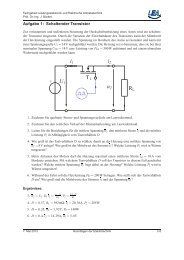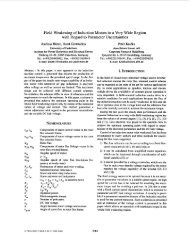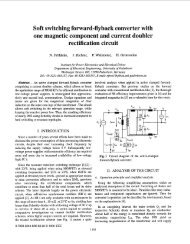Organization and Control of Autonomous Railway Convoys
Organization and Control of Autonomous Railway Convoys
Organization and Control of Autonomous Railway Convoys
Create successful ePaper yourself
Turn your PDF publications into a flip-book with our unique Google optimized e-Paper software.
AVEC ’083. CONTROL OF LONGITUDINAL DYNAMICSThe longitudinal control <strong>of</strong> a vehicle requires amodel <strong>of</strong> the vehicle dynamics <strong>and</strong> the actuators whichare presented first in this section. With thismathematical description the controller can be designed.3.1 Vehicle DynamicsA mathematical model <strong>of</strong> the vehicle dynamics ism<strong>and</strong>atory for the controller design. It includes thedynamic behavior <strong>of</strong> the electric drive <strong>and</strong> the vehiclekinematics. The following assumptions for the vehicledynamics are made:• Complete decoupling <strong>of</strong> longitudinal <strong>and</strong>lateral dynamics• No slip in longitudinal direction betweenwheels <strong>and</strong> railThe vehicles represent a moving mass m n with thesecond order dynamics1& xn = ( FM,n− Froll,n− Fdrag,n− Fslope,n) , n ∈ { 1..N}(5)mnwhereas F M,,n represents the motor thrust <strong>and</strong> F roll , F drag ,F slope are disturbances. Crucial for the longitudinalcontrol are the limitations. The motor thrust for the testvehicles is limited to 1100 N. The vehicle mass <strong>of</strong> about1250 kg results in a maximal acceleration <strong>of</strong> 0.8 m/s 2 onplane track sections. The maximum speed is 10 m/s dueto the tight curves on the test track.The roll resistance <strong>of</strong> railway vehicles is small <strong>and</strong>can be approximated here to be less than 30 N. The airresistance is proportional to v 2 . It is less than 50 Nbecause <strong>of</strong> the low speed <strong>of</strong> the test vehicles. It isapproximated to be nearly independent <strong>of</strong> the vehiclespeed when head wind <strong>and</strong> down wind are alsoconsidered. However, the downhill slope force cannotbe neglected. It constitutes 570 N at the biggest incline.The applied linear motor is a direct drive whichresults in a linear model with the motor voltage U M,n asthe sole input <strong>and</strong> the vehicle position x n as the singleoutput as shown in Fig. 3.Fig. 3Modeling <strong>of</strong> a longitudinal dynamics3.2 <strong>Control</strong> StructureA controller for the longitudinal dynamics has to bedesigned considering the following constraints:• Automatic adaption to the vehicle mass• Desired driving comfortTherefore the control system includes a referencegenerator which considers the vehicle mass m n <strong>and</strong> thelimits <strong>of</strong> the acceleration an,max <strong>and</strong> the jerk r n, max .The feedback <strong>of</strong> current position <strong>and</strong> speed ism<strong>and</strong>atory for the position control (see Fig. 4). Afollow-up control is applied with set point tracingx * *n ' = x n − d n,brake . The braking distance d n,brake iscalculated by the speed v n <strong>and</strong> the maximal accelerationa n . The acceleration a n depends on the vehicle mass m n<strong>and</strong> the position x n as well as the gradients <strong>of</strong> the trackgiven by a digital map.A cascaded control structure has been realized forthe longitudinal control. The cascaded structure allowslimiting the inner control variables. The innermost loopis the motor current control with a superordinated speedcontrol loop. The outermost control loop constitutes aposition control. The time pattern for the control <strong>of</strong>longitudinal dynamics is 1 ms. The linear motorprovides a constant traction independent <strong>of</strong> externalperturbations. Therefore jerk <strong>and</strong> acceleration limits canbe guaranteed without employing an accelerationcontrol loop.Fig. 4Structure <strong>of</strong> longitudinal control4. STRUCTURE OF CONVOY CONTROLSYSTEMThe convoy control requires a wireless networkbetween the RailCabs. Consequently, an extension <strong>of</strong>the control system is required as shown in Fig. 5.Fig. 5Structure <strong>of</strong> the control system4.1 Network <strong>Control</strong>led SystemDriving within a distance between vehicles <strong>of</strong> lessthan a meter requires information from the in frontdriving vehicle as well as from the convoy leader. If acommunication to the leader exists, convoy stability canbe ensured [4] even in case <strong>of</strong> speed independentreference distances [12]. Additionally early reactions ondisturbances can be achieved [13] when the desiredtrajectory <strong>of</strong> the leader <strong>and</strong> its acceleration is known.The absolute position <strong>of</strong> the vehicles is veryprecisely measured. Therefore, it is used for distancecontrol in addition to the distance information measuredby the distance sensors. However, the transmitted dataalso includes the speed information. Furthermore thedesired trajectory <strong>of</strong> the leader is transmitted.Fig. 6Communication structureThe leading vehicle communicates its data via



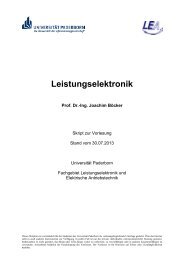

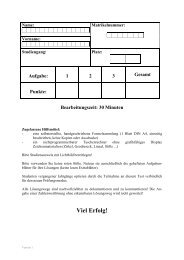
![[ ] Ï - Fachgebiet Leistungselektronik und Elektrische Antriebstechnik](https://img.yumpu.com/51151382/1/184x260/-i-fachgebiet-leistungselektronik-und-elektrische-antriebstechnik.jpg?quality=85)
